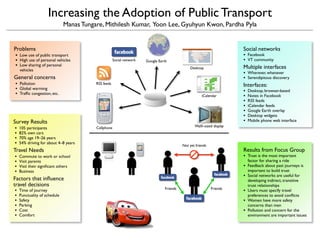Increasing the Adoption of Public Transport Through Multi-Platform Social Networking
- 1. Increasing the Adoption of Public Transport Manas Tungare, Mithilesh Kumar, Yoon Lee, Gyuhyun Kwon, Pardha Pyla Problems Social networks ŌĆó ŌĆó Low use of public transport Facebook ŌĆó ŌĆó High use of personal vehicles VT community Social network Google Earth ŌĆó Low sharing of personal Multiple interfaces Desktop vehicles ŌĆó Wherever, whenever General concerns ŌĆó Serendipitous discovery ŌĆó Pollution RSS feeds Interfaces: ŌĆó Global warming ŌĆó Desktop, browser-based ŌĆó Traf’¼üc congestion, etc. ŌĆó Notes in Facebook iCalendar ŌĆó RSS feeds ŌĆó iCalendar feeds ŌĆó Google Earth overlay ŌĆó Desktop widgets ŌĆó Mobile phone web interface Survey Results WalllŌĆōsized display ŌĆó 105 participants Cellphone ŌĆó 82% own cars ŌĆó 70% age 19ŌĆō26 years ŌĆó 54% driving for about 4ŌĆō8 years Not yet friends Results from Focus Group Travel Needs ŌĆó Trust is the most important ŌĆó Commute to work or school factor for sharing a ride ŌĆó Visit parents ŌĆó Feedback about past journeys is ŌĆó Visit their signi’¼ücant others important to build trust ŌĆó Business ŌĆó Social networks are useful for Factors that in’¼éuence developing indirect, transitive travel decisions trust relationships Friends Friends ŌĆó ŌĆó Time of journey Users must specify travel ŌĆó Punctuality of schedule preferences to avoid con’¼éicts ŌĆó ŌĆó Safety Women have more safety ŌĆó Parking concerns than men ŌĆó ŌĆó Cost Pollution and concern for the ŌĆó Comfort environment are important issues

